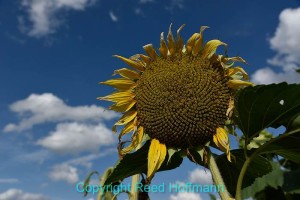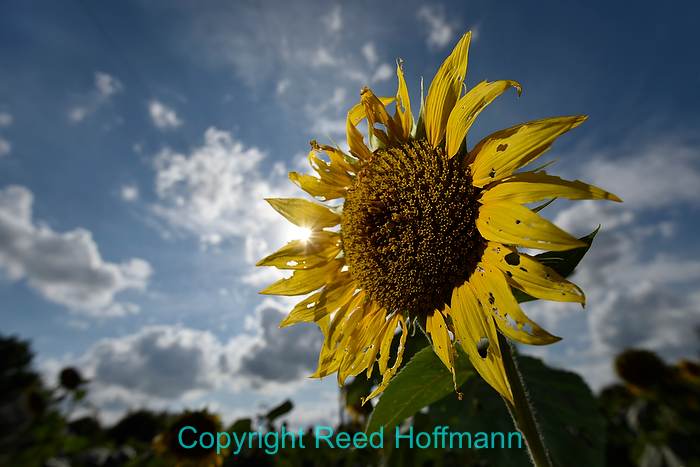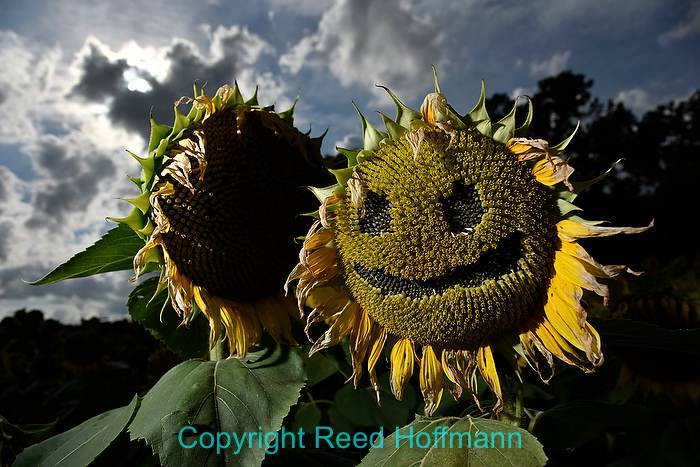I’m a big fan of planning. Thinking through what you’re going to do, having the right gear, being prepared – those are all important to being successful. But things don’t always go the way we plan. So it’s just as important to be flexible, prepared to toss that original idea and start fresh. Which is what happened yesterday.
Kansas is known as the Sunflower state. And outside of Lawrence, KS, is a farm where they have a tradition of planting sunflowers and welcoming people to visit and take pictures. So a couple of friends and I decided to head out there yesterday. Beautiful afternoon, sunny, blue sky and patchy white clouds – perfect conditions. Until we got there and found they were past their prime (no one mentioned that on Facebook). Losing color, wilted, faded. We missed them by about a week. So much for this shoot, right? Maybe not.
As a teenager getting started in photography, when I ran into problems, the guy who was my mentor always said, “You going to let that outsmart you?” And still today, whenever I get stumped by something, that phrase pops into my head (thanks again, Kent!). That, combined with being a newspaper photographer for many years, has shaped how I approach photography. You see, at newspapers you’d get an assignment and be expected to come back with a picture. It didn’t matter if things didn’t work out as planned, you still had to come back with a picture. And it better be a good one, or you could be looking for another job.
So there we are in this wilted field of sunflowers, and I say, “No problem, we can make this work.” How? Well, you look at what’s there, what’s good, and you work with that. We had a great sky with good light, and the sunflowers still had their trademark shape. So those would be what we’d focus our efforts on.

Great sky, wilted sunflower. Not what we had hoped for. And being front-lit (sun behind me) doesn’t add much drama to the photo. Nikon D810, Manual, ISO 100, 1/640 at f/7.1, EV -0.7, Nikon 24-120mm lens at 30mm. Photo copyright Reed Hoffmann.

Now with the sun behind the sunflower, I’ve got a much more interesting picture. But that also means the front of the flower is in shadow. Nikon D810, Manual, ISO 100, 1/320 at f/16, EV -0.7, Nikon 16-35mm lens at 19mm. Photo copyright Reed Hoffmann.
Direction of light is always important in photography. Side-light brings out shape and texture. Problem was, almost all the sunflowers were turned away from the sun. Choosing a position that showed the face of the sunflower put it in shadow. And with the sun behind it, either the sky was overexposed or the sunflower was a silhouette. Silhouettes can be dramatic, but then I’d lose the color of the sunflower. So the answer was adding light to the face of the sunflower. And I’d need something as powerful as the sun. Luckily I had that in my bag – a flash.
The main issue with using flash is the direction of light it produces. On-camera flash means front-light, which is flat and boring. When I teach flash, the most important lesson is getting the flash away from the camera. In the old days we did that with a wire, but many of today’s cameras have the ability to control a flash detached from the camera, without wires or other accessories. On the Nikon cameras I use, that’s called “Commander Mode.” And the D810 camera and SB-500 flash that I had with me could both use that.
Now I could position the sunflowers against the sun, with that dramatic sky as a background, and holding the flash off to the side (remember, side-light is more interesting) make a nice picture.

By adding flash, I can bring out the color and detail in the sunflower. And holding it off to the side brings the light in at an angle, which creates shadows and a sense of depth and texture. See the starburst? That’s caused by the small aperture (f/16) and having the sun partially blocked by the petals. Nikon D810, Manual, ISO 100, 1/2000 at f/8, EV -0.7, Nikon 16-35mm lens at 19mm. Photo copyright Reed Hoffmann.
The last part of this challenge was exposure. If I left the camera on Automatic, I’d struggle to get the sky dark and dramatic. To manage that, I switched the exposure mode to Manual. This is something I regularly do with flash. Set the camera to Manual exposure, find the shutter speed and aperture that make the background look the way I want it, then turn on the flash to light the subject. This camera (the Nikon D810) helps me with that by having what Nikon calls “Auto FP,” sometimes referred to as “high-speed sync.” That lets me break the sync shutter speed barrier, so I can shoot at shutter speeds over 1/250 second.
With all that in place, I could now take advantage of that beautiful day and make some nice photos, even though they weren’t what I’d envisioned. And that’s what photography is really all about. Taking what you’ve got and making the best of it. Using the tools you’ve got and the skills you’ve learned, to make something special. And you know what I call that? Outsmarting it!
(If you want to learn more about how to use flash effectively, join me for one of the Nikon School classes I’m teaching about flash. There’s a three-hour “Creative Lighting” class, and an all-day, hands-on class called “Portrait and Lighting”)


